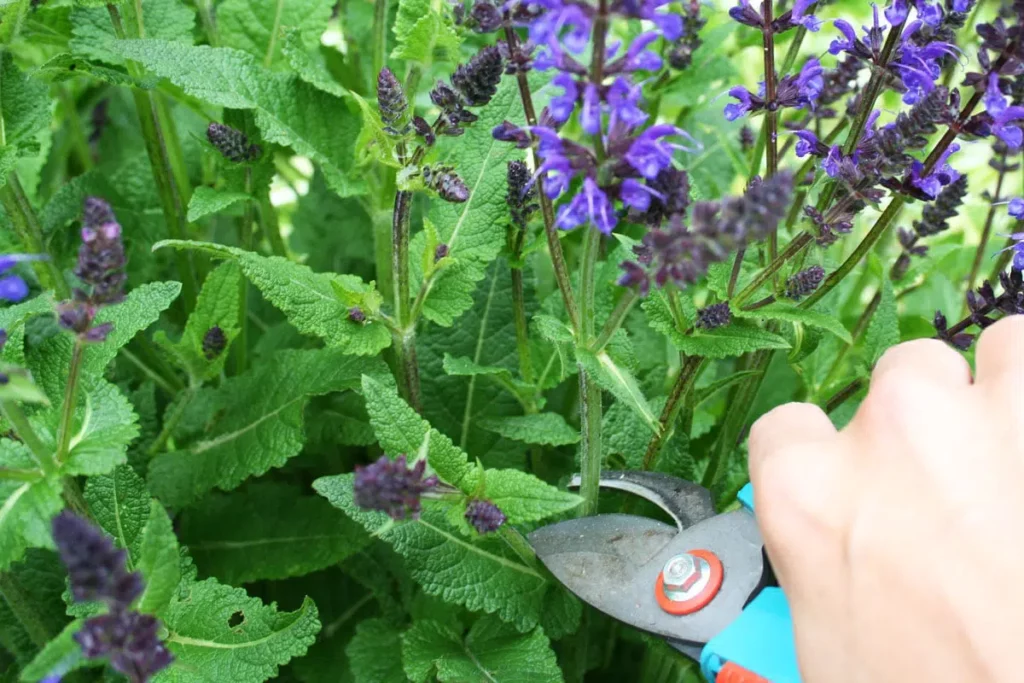Sage is a culinary herb and medicinal plant at the same time. It has a distinctive flavor and unique aroma. In order for sage to develop both to a great extent, you need to cut back the different species at the right time.
- Pruning time varies within the species
- Main pruning time for garden sage in early spring
- for ornamental sage after flowering
- summer pruning at the same time as harvest pruning
- do not cut after August
Contents
The right time
There are different pruning times for sage, with late winter and summer playing a significant role both before during and after flowering. Other factors regarding pruning time that should not be underestimated are the different growth forms or the goal of the pruning measures. While in the case of kitchen or spice sage, the main aim is to counteract progressive lignification, in the case of ornamental sage such as the steppe sage, the main aim is to achieve a lush bloom. Accordingly, the times for the respective pruning measures are variable.
Pruning in late winter
Late winter is the prime pruning time for true, spice or kitchen sage. The frost-free periods are best suited for central maintenance pruning of old, shabby shrubs as well as for encouraging new shoots. Radical pruning is also possible in late winter. However, this should be spread over two cuts.
- Maintenance pruning only after the second year of growth
- best annually
- depending on the region from the end of February to the middle/end of March
- as soon as no more severe frosts are expected
- as long as new shoots have not yet started
- do not prune if new shoots have already appeared
- Cut back ornamental sage close to the ground in late winter.
Note: When pruning, the provisions of the Federal Nature Conservation Act must be observed, according to which radical pruning of hedges, shrubs and bushes is prohibited between March and September due to the breeding season of many birds. Gentle shaping and maintenance cuts, on the other hand, are permitted, provided that no animal is disturbed in the process of nesting.
Before/during flowering
After late winter pruning comes the time for recurring cuts such as pinching or pruning out, although smaller cuts can be made at any time. Now is also the right time for harvest pruning of garden sage.
- from about the middle of May to the beginning of August
- from mid-May, regularly prune young plants
- cut back complete herbaceous shoots at the end of May/beginning of June
- remove disturbing branches from the beginning of June down to the wood
- cut off blossoms from June to July
- from mid-August, do not cut back kitchen sage any more

Tip: flowers should be cut only if self-seeding is not desired.
After flowering
The period after flowering is especially interesting for ornamental sage, because now is its main pruning time the so-called remontage cut. This should be done after the first flowering.
- pruning before flowers completely wither
- leads to second flowering in early autumn
- remove wilted flower stems in mid-July to early August
- Cut sage back to a hand’s width above the ground
- or shorten to one third
- do not cut after second flowering
Pruning sage: this is important
If sage is cut back incorrectly or not at the right time, it can cause lasting damage to the plants and even lead to total failure. If the right time was missed, it is better to postpone the cut. To ensure that sage recovers quickly and sprouts vigorously after pruning, whether in early spring, before or after flowering, a few things must be considered.
- do not prune in the fall
- do not cut during frost because of poor wound healing
- do not cut too deep
- cut only in the leafy area, not into the old wood
- do not remove woody shoots
- Sage sprouts again here
- Always cut just above the woody part of the shoot.
Tip: To avoid damage to old and young wood, it is important to use only sufficiently sharp and previously disinfected cutting tools.
Frequently asked questions
What happens if sage is not cut at all?
If sage is not pruned at all, oversized growth and massive lignification usually occur. The yields are always lower. To prevent this, only regular pruning at the right time will help.
Can sage be pruned in the fall?
Pruning in the fall is not recommended because it would deprive the sage of its winter protection. If you prune in early spring, it will retain its foliage throughout the winter and can protect itself from frost and cold. Harvesting can, of course, still be done in the fall, only stronger cuts should be avoided.
Is ornamental sage, especially steppe sage, edible?
Even though ornamental sage, i.e. rock sage, is not poisonous, it is hardly suitable for consumption, especially since its leaves contain very little aroma. It rather scores with its bright flowers and a pleasant fragrance. However, for many insects, its flowers are a valuable source of food.


